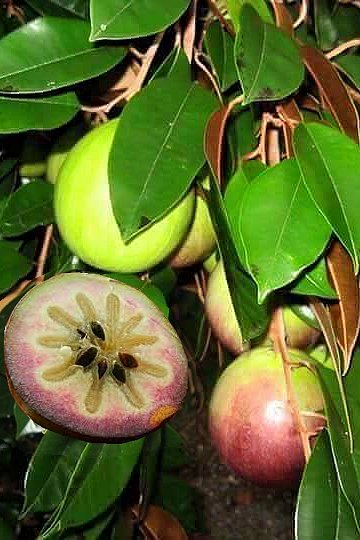
|
|
Star Apple (Chrysophyllum cainito).
|
Star Apple - Chrysophyllum cainito
Chrysophyllum cainito is a tropical tree of the family Sapotaceae. It is native to the Greater Antilles and the West Indies. It has spread to the lowlands of Central America and is now grown throughout the tropics, including Southeast
Asia. It grows rapidly and reaches 20 meters in height.
The generic name ( Chrysophyllum) is based on Greek words for ‘gold’ and ‘leaf’ and refers to the leaves of some species that are often covered with golden hairs underneath. When the fruit is halved transversely, these cut segments present a star-like appearance, giving the tree the common name of ‘star apple’. Two races are common, one green fruited and the other purple fruited; they are not known to differ in flavour or other characteristics except colour.
The fruit has numerous names. The common names cainito and caimito likely come from the Mayan words cab (juice), im (breast), and vitis (sap), via Spanish.
Chrysophyllum cainito is an evergreen tree that can grow up to a height of 15 m and trunk diameter of 60 cm. Bole usually straight, cylindrical, but often fluted or spurred at the base; bark surface rough, irregularly fissured and
brown. Young twigs reddishbrown and hairy.
The leaves are evergreen, alternate, simple oval, entire, 5–15 cm long; deep green, hairless and glossy
above. the underside shines with a golden color when seen from a distance. Petiole 1.5 cm long, reddish-brown, hairy.
The tiny flowers are purplish white, axillary
and have a sweet fragrant smell. The tree is also hermaphroditic (self-fertile). It produces a strong
odor.
The fruit is globose and typically measures from 2 to 3 inches in diameter. When ripe, it usually has purple skin with a faint green area appearing around the calyx. A radiating star pattern is visible in the pulp. Greenish-white,
red and yellow-fruited cultivars are sometimes available. The skin is rich in latex, and both it and the rind are not edible. The flattened seeds are light brown and hard. It is a seasonal fruit bearing tree.
The edible fruit is held in much the same estimation as Zapote. It is usually eaten fresh and may also be used as an ingredient of ice cream and sherbet. In Jamaica it is sometimes made into preserves. When unripe, the star apple contains a sticky, astringent, latex, but on ripening, a white translucent pulp with a sweet and pleasant flavour is formed around the dark seeds. The ripe fruit, preferably chilled, is cut in half and the flesh spooned out, leaving the seed cells and core. An emulsion of the slightly bitter seed kernels is used to make imitation milk-of-almonds or nougat and other confections.
The ripe fruit is eaten to sooth inflammation in laryngitis and pneumonia. It is given as a treatment for diabetes mellitus, and as a decoction is gargled to relieve angina. The fruit is used in treating haemorrhage or is cooked and used for fever. A decoction of the rind, or of the leaves, is taken as a pectoral. The undersides of the leaves are grated and applied as a poultice to wounds. A decoction of the leaves is taken orally to treat hypoglycaemia. A decoction of the tannin-rich, astringent bark is drunk as a tonic and stimulant, and is taken to halt diarrhoea, dysentery and haemorrhages, and as a treatment for gonorrhoea and catarrh of the bladder. The bitter, pulverized seed is taken as a tonic, diuretic and febrifuge.
The latex of the tree is applied on abscesses and, when dried and powdered, it is given as a potent vermifuge. It is also taken as a diuretic, febrifuge and remedy for dysentery.
Source:
https://en.wikipedia.org/wiki/Chrysophyllum_cainito
https://pfaf.org/USER/Plant.aspx?LatinName=Chrysophyllum+cainito
http://apps.worldagroforestry.org/treedb/AFTPDFS/
Chrysophyllum_cainito.PDF
